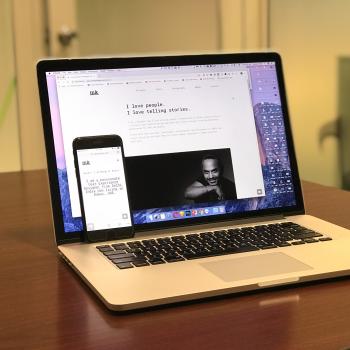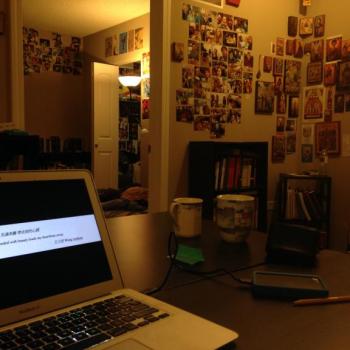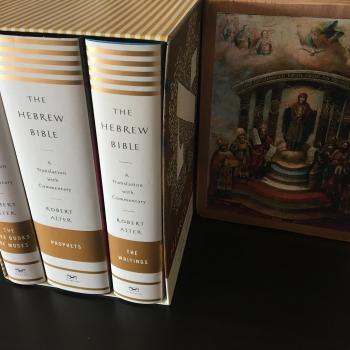It’s a cliché to say that one’s students will teach a teacher more than a teacher can teach them. If one were to cynical, one might quip that this is really false humility. And thus when I say that in my first course that I ever taught — the University of Washington’s American Religion class — that my students taught me more than I taught them, I risk sounding trite.
After more than a month of reflection on what actually happened in that classroom – the course finished in late March – I think I can finally articulate what my students taught me. It’s this: my students taught me how to run a secular classroom.
How did they do that? Spoiler alert: it means that we have to assume as a class that everyone from every possible strand of the religious spectrum is listening and can talk back. Charles Taylor calls this the nova effect of new religious subjectivities in a secular age. It’s an explosion of infinite possibilities of the (non)transcendent. And you have to talk like everyone’s there because that’s the nature of the ecumene, the inhabited geographies of religion in the contemporary world. A secular classroom is thus a radically ecumenical classroom — and by ecumenical, I don’t just mean Christian, as you’ll see toward the end.
I feel compelled to blog about this right now because some of my students attended a series of lectures that James K.A. Smith gave here recently at the University of Washington.The talks centered on Smith’s new book, How (Not) to Be Secular: Reading Charles Taylor. It’s because of this theme that a few friends and I coined a new hastag: #SourcesoftheSelfie.
Smith tried to unpack for us what Charles Taylor means by the ‘secular.’ Capitalizing on the regional mythology of the Pacific Northwest being what Patricia Killen and Mark Silk call the ‘none zone’ (i.e. that the region has the most who identify as ‘not religiously affiliated’ in quantitative relationship to the rest of America), Smith and his interlocutors tried to unpack the phenomenon of being ‘spiritual but not religious.’ Smith emphasized Taylor’s point about ‘cross-pressures,’ that most people who would self-describe as having an ‘immanent frame’ that finds fulfillment and happiness in material things in the world still have a sense that there is something more ‘out there.’ Because Smith was speaking to an audience that he presumed would be mostly evangelical — he was invited by the Graduate Christian Fellowship and hosted by Fuller’s Pacific Northwest satellite campus at an evangelical Seattle hub, University Presbyterian Church — he spoke, as it were, to an ecclesial audience. His point was that those ‘hauntings’ remain in a secular age suggested for Smith that the ‘spiritual but not religious’ may in fact have something to teach Christians, especially Christians who write off the ‘spiritual but not religious’ as the worst thing to come about after the demise of Christendom. How (Not) to be Secular turns out to be a call to the Christian church about how to go about being Christian in a secular age.
What was remarkable was how much Smith’s ecclesial audience was assumed to be evangelical Protestant. I say this not to unsettle Smith’s talk, but to move into how the talk was then received. In an effort to draw Smith out, the organizing parties put together a panel with Drs. Chelle Stearns (Seattle School), David Leong (Seattle Pacific University), and James K. Wellman, Jr. (University of Washington, Comparative Religion)
The thing that struck me the most during the panel was how much Jim Wellman’s comments suggested that whatever it was we were talking about, this was old news for the University of Washington’s Comparative Religion Unit. Wellman has grieved very publicly over the death of his wife last year, and as he was reflecting on spirituality, he brought up the work of the founder of UW Comparative Religion, Eugene Webb. If there’s any way to describe Webb, it is that when the guy speaks and writes, he invokes the complete breadth of the Christian ecumene, both East and West, Protestant, Catholic, Orthodox, right and left, Voegelin, Lonergan, Girard, and even goes into forays into post-Christian psychoanalysis. Webb’s most recent book is In Search of the Triune God, a comparative account of the politics of Trinitarian theology in producing the political division between Orthodox and Catholic theologies and in generating contemporary geopolitical formations. Wellman said that as he was grieving, it was Webb who was the most helpful to him, as he pulled out the entire Christian ecumene to say to him, ‘The world is a vast experiment in incarnation.’ If you’ve read Webb’s stuff, you know that in that one sentence meant to comfort, he has combined all the resources of Western and Eastern Christianity to make that one sentence cohere.
Wellman then developed that point into what he frequently tells clergy – that in a world where mainline denominations and independent congregations don’t usually have enough money to pay clergy well, they may have to be bivocational. Lest you think this is a mainline decline narrative that only liberal Protestants espouse, SPU’s David Leong said that he felt it hard to tell his divinity students that this was really the reality even among evangelicals. What’s remarkable is that both Wellman’s and Leong’s comments invoke Dietrich Bonhoeffer’s ‘religionless Christianity.’ Again, here’s the breadth of the ecumene coming back to haunt the panel. SBNR is nothing new, and Charles Taylor isn’t saying anything novel, because what has been said has already been suggested by Bonhoeffer sixty years ago.
But what was then fascinating was hanging out with some of my American Religion students and their friends, a Dominican priest, Jim Wellman, Artur Rosman, a few Comparative Religion graduate students from various (ex)theological backgrounds, and my wife at the Catholic Newman Center afterward. Building off the comments on religionless Christianity, Smith then articulated his dream for the church: that it be marked as the people of God who embody in their diversity who Christ is. As Smith was talking, my Catholic students, the Dominican priest, and Artur looked at each other. What Smith was describing wasn’t a dream; it was how the Newman Center was run! This is not to say that Catholics don’t have their own problems — indeed, having given talks to Catholics recently and heard their responses, I’ve got one or two things to say — but it occurred to me that what was a Protestant dream was the Catholic ‘duh.’ Our discussion of the Newman Center in turn took the talk in directions further than the SBNR conversation, but into an in depth debate over how the ‘secular’ should even be defined. This is because Protestants can’t assume that when they talk about Catholics, the Catholics aren’t in the room. The Catholics were there. They had their own lived reality to share and questions from the broader ecumene that would have disrupted the entire Protestant framework of the SBNR conversation.
As we discussed Smith’s talk, it hit me that this is precisely what my students had been teaching me all along in American Religion: the point of a secular classroom is that it forces everyone from a variety of theological ontologies and assumptions to talk to each other. I was told — and I fully believe — that for this first teaching gig, my students were without exaggeration the cream of the crop. This is largely because much of the discussion in the classroom happened without me prodding. As students repeatedly told me, it was remarkable that they all cared so much about the subject matter. An Orthodox Jewish student informed me that by plunging into the theological imaginations of Puritans, cavalier Virginians, Quakers, and New Light Presbyterians, his understanding of Protestant privilege had been completely upset. When the Catholic students came to understood how a fundamentalist imagination worked and why fundamentalist Protestants thought they weren’t Christian, they started to be able to make sense of their interactions with fundamentalist/evangelical friends. When the evangelicals in the class were exposed to liberal mainline Protestantism, their understanding of the liberal ‘nemesis’ was torn to shreds. When the Japanese exchange students insisted that they had a language barrier and that Japanese people don’t talk about religion, they then wrote some of the most illuminating papers I read about their experiences of race and religion in America.
The list goes on — and I have direct quotes from their final exams that would prove my point even better (but I won’t post them publicly for fear of embarrassing them) — but I want to insist that what I did in American Religion was what we’ve always done at the University of Washington’s Comparative Religion Unit. Our unit embodies the beating heart of the secular university because we were founded by a lawsuit. In the 1960s, a group of fundamentalist pastors from Bellevue sat in on an English class called ‘the Bible as Literature’ and filed a judicial complaint that the university was using public monies to teach a narrowly ‘liberal Protestant’ theology that excluded fundamentalist theologies. They lost the case, but what happened was that the university then put together a comparative religion unit, hid it with the rest of the area studies people, and made Eugene Webb the chair. It’s from this whole thing that Webb cultivated the unit into what it’s known for: we plunge students into every theological imagination we have time for because that’s what we understand a public secular classroom to do.
Though the fundamentalists lost the case, perhaps they had a point: we needed to talk as if they were in the room – which, by the way, is why we had a whole unit on fundamentalism in my class. It’s because if this is really a public university, then our classrooms are invested in ‘the public’ — the ecumene, indeed a secular ecumene marked by the nova effect where comments about religion are never private. When we plunge into theologies that compose this ecumene, we have to be cognizant that the entire ecumene is in the room. By constantly talking back to me, my students constantly reminded me that to talk about the ecumene as if it were the room was not a figment of my imagination. It was real. They were there, and they demanded fairness to their diverse theological imaginations. It’s because of this that they taught me more than I taught them.











